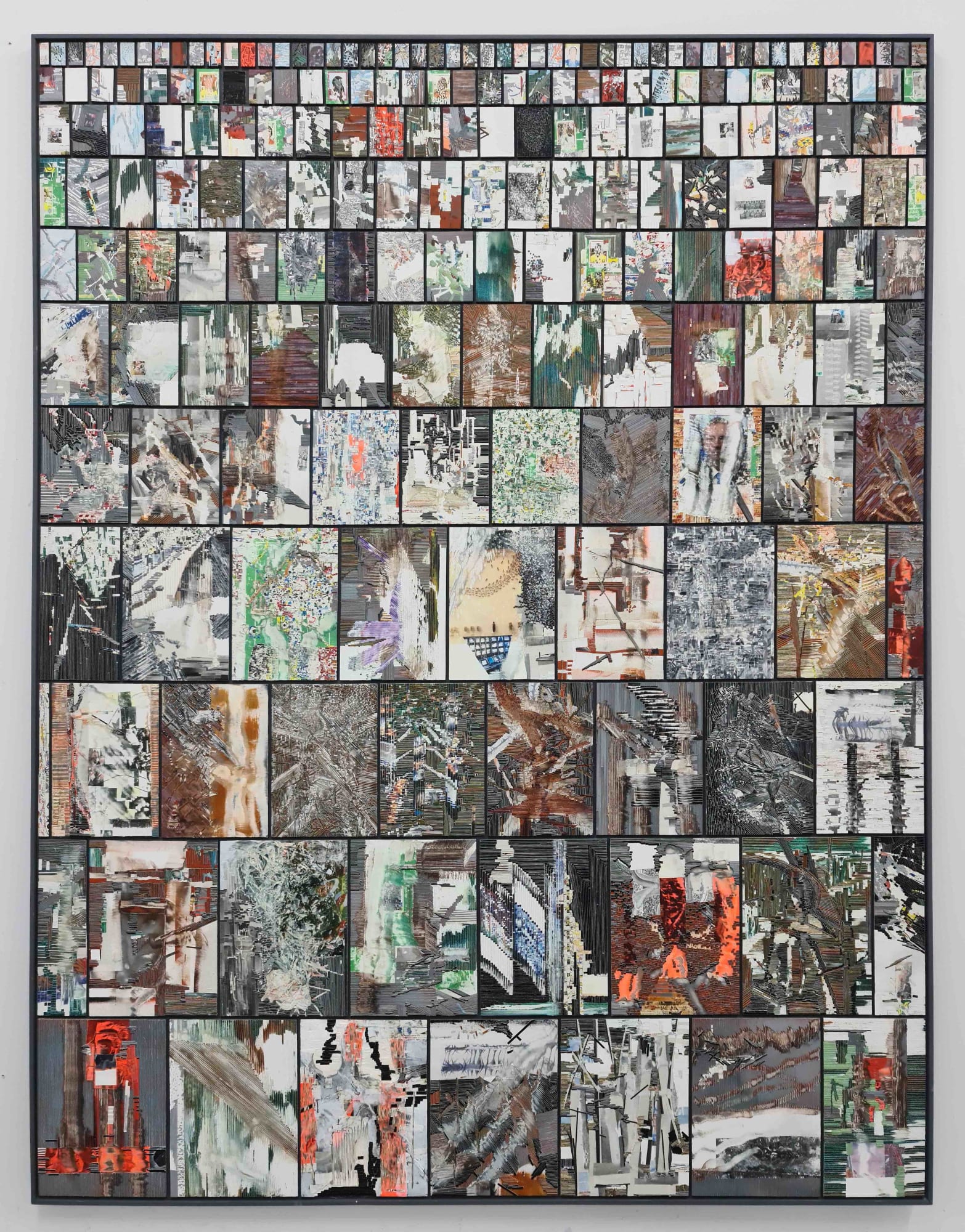Marcin Dudek
Faces in the Crowd, 2020
Acrylic paint, oil paint, steel dust, image transfer, UV varnish on wood and aluminium
220 x 170 cm
86 5/8 x 66 7/8 in.
86 5/8 x 66 7/8 in.
Copyright the artist
Entering into any crowd, our first impression is that of a vibrant, coherent mass of people. Gathered together for a common purpose, the group shares a certain identity, such as...
Entering into any crowd, our first impression is that of a vibrant, coherent mass of people. Gathered together for a common purpose, the group shares a certain identity, such as sports fans, political protesters, or concert goers. A certain set of beliefs is already cast upon each of the participants, who become insignificant in the face of a larger whole. Taking interest in the separate individuals who contribute to the energy of a mass group, Marcin Dudek has created a work made up of 208 abstract portraits. While a crowd can often give us anonymity as we become numbers rather than individuals, each person plays a role and has a distinct complex life which extends far further than a single event. Through this work, Dudek plunges into a research to find out who these people are.
Though the main visual material for the piece principally focuses on images of stadiums in England and Russia, which show a similar crowd dynamic but with very different geopolitical contexts, images are used from a large range of sources. Dudek pulls out individuals such as participants from fascist rallies during the time of Mussolini and an image of a MET Police agent with extremely developed facial recognition skills. The linearity of the graphic language in the work itself serves as a tool to categorize the spectrum of human beings. This typification of homosapiens is perhaps the most striking in the usage of football cards, in which the identity of the athlete has been erased. The player’s ‘‘identity’ becomes more of a costume; a typification of a person without any identifiable qualities other than their preferred sport.
Just as faces become more indistinguishable the farther away they are, the portraits become smaller and contain less information the higher they are on the work. Dudek has also structured this as one may structure a newspaper’s archive; we know most about the generations closest to our own, and as time regresses each individual becomes more a notion of a person rather than a detailed figure. The smallest portraits represent individuals from the pre-industrial era: revolutionaries who were part of riots or political movements, carpenters and family members, who are all but forgotten save for their presence in historic events. They form a dead crowd, who is no longer present but whose voices are still being heard, shaping our present world.
The notion of picking out individuals from a crowd also evokes more contemporary issues of surveillance and facial recognition technologies. Whereas we could once blend in and find security in the protection of an anonymous mass, this safe haven has now been dismantled. As we saw in the London riots in 2011, individuals are picked out by CCTV and other technologies, their faces plastered in the news as a warning to others. This serves as a sort of peer pressure, unmasking the participants and showing that nobody can hide from the law. This brings our attention back to the role of each participant in a crowd, who has a certain pressure to fulfil their role in order to contribute to the success of a mass happening.
Though the main visual material for the piece principally focuses on images of stadiums in England and Russia, which show a similar crowd dynamic but with very different geopolitical contexts, images are used from a large range of sources. Dudek pulls out individuals such as participants from fascist rallies during the time of Mussolini and an image of a MET Police agent with extremely developed facial recognition skills. The linearity of the graphic language in the work itself serves as a tool to categorize the spectrum of human beings. This typification of homosapiens is perhaps the most striking in the usage of football cards, in which the identity of the athlete has been erased. The player’s ‘‘identity’ becomes more of a costume; a typification of a person without any identifiable qualities other than their preferred sport.
Just as faces become more indistinguishable the farther away they are, the portraits become smaller and contain less information the higher they are on the work. Dudek has also structured this as one may structure a newspaper’s archive; we know most about the generations closest to our own, and as time regresses each individual becomes more a notion of a person rather than a detailed figure. The smallest portraits represent individuals from the pre-industrial era: revolutionaries who were part of riots or political movements, carpenters and family members, who are all but forgotten save for their presence in historic events. They form a dead crowd, who is no longer present but whose voices are still being heard, shaping our present world.
The notion of picking out individuals from a crowd also evokes more contemporary issues of surveillance and facial recognition technologies. Whereas we could once blend in and find security in the protection of an anonymous mass, this safe haven has now been dismantled. As we saw in the London riots in 2011, individuals are picked out by CCTV and other technologies, their faces plastered in the news as a warning to others. This serves as a sort of peer pressure, unmasking the participants and showing that nobody can hide from the law. This brings our attention back to the role of each participant in a crowd, who has a certain pressure to fulfil their role in order to contribute to the success of a mass happening.

